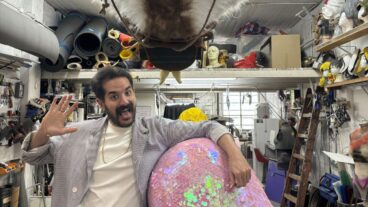Forty-seven groups of high school students from Jewish and Arab cities across Israel are competing in the 18th FIRST Robotics Competition – 2009. Photo credit Liat Mendel.
Most high-school science nerds have it hard enough without having to do projects under fire. But as the brainiac participants in the 18th FIRST Robotics Competition (FRC) all over the world began building their mechanical monsters this week, the teams from Ashkelon, Beersheva, Tel-Nof and other areas in Israel’s south were doing the same – or trying to – in the face of school closures and missile attacks.
But there are only six weeks before the FRC tourney in Tel Aviv and time is at a premium. Speaking from his home safe-room, 17-year-old Barak Palesznicki, the Ashkelon team leader, explained to ISRAEL21c that though school was cancelled, his group had planned to begin work in their school’s bomb shelter but that the meeting was called off because a GRAD missile fell nearby the school.
The team’s adult mentors are now trying to find an alternate location. “I hope this week we’ll get a place because the other teams are already working on their robots and we’re not. And every minute counts,” he says.
FIRST (For Inspiration and Recognition of Science and Technology) was founded by Dean Kamen, inventor of the Segway and iBot, to use robotics as an inspiration for youngsters to study technology and science.
FRC is an annual competition for students in grades 10-12 that challenges them to solve common problems inherent in control system design. Each year, a challenge is unveiled and identical materials distributed to teams that must build a robot which can successfully complete the test, and compete against other robots. Team hierarchy is organized along high-tech industry lines to operate like a start-up, including raising funds through sponsorships.
More than 42,000 high-school students on 1,686 teams from the US, Brazil, Canada, Chile, Germany, Israel, Mexico, the Netherlands, the Philippines, Turkey, and the UK are participating in this year’s competition. Some 47 groups of high school students from Jewish and Arab cities across Israel – Ashkelon, Usfia, Haifa, Jerusalem, Lod, Beersheva, Tel Aviv, Hod Hasharon, Dimona, Jatt, Umm El-Fahim, Tamra, and others – are competing in FRC 2009.
Lunacy amidst the madness
This Sunday, the students convened at the Air Force House in Herzliya to receive their robot building material kits (made up of motors, batteries, a control system, and a mix of automation components – but no instructions) and learn this year’s challenge. They were also treated to a presentation by the FRC 2008 winners, Aviv High School in Ra’anana, whose challenge last year was to design a robot that could drive around a track, pick up balls strewn there and drop them into baskets.
This year’s challenge, called “Lunacy”, explains Asaf Agmon, CEO of FIRST, requires the teams to design robots that can pick up nine-inch game balls and score them in trailers hitched to their opponents’ robots for points during a two minute and 15 second match. Additional points are awarded for scoring a special game ball, the Super Cell, in the opponents’ trailers during the last 20 seconds of the match. Lunacy is played on a low-friction floor, intended to mimic the physical challenges of the moon’s surface.
“In six weeks, on the same day all over the world, the regional competitions will take place,” says Agmon, adding that the Tel Aviv municipality has donated the Nokia stadium in Yad Eliahu for the three-day event. “After that, the winning teams fly to compete in the international finals in Atlanta. And our groups have always done Israel very proud.”
Two years ago, Agmon notes, one of the Israeli teams to reach the finals was comprised almost entirely of religious Arab girls from the village of Tamra, many of whom have gone on to study at the Technion – Israel Institute of Technology.
“What’s beautiful about FIRST Israel is that we have groups from different kinds of schools: academic, technical-vocational, religious, secular, primary, junior-high and high school. At the FRC kickoff, all the kids – Arabs and Jews, religious and secular, girls and boys – sat together. We brought the kids from Ashkelon, Beersheva and Tel Nof up onstage and everyone applauded them,” says Agmon.
Teen life during wartime
Down on the Ashkelon homefront, Palesznicki says: “I’m just trying to make some sort of routine which isn’t working out so well. This morning it was quiet so I hope it will stay like that. I was looking Lunacy up on the web yesterday when there was a siren. I’ll try again today. We’re trying to keep in contact by phone but it’s kind of hard – we check up on one another but the lines get overloaded and crash after an attack and you can’t always call. But normally, I try to update them on what’s going on.”
In mid-conversation with ISRAEL21c, a siren sounds, warning of an incoming missile. Palesznicki pauses to make sure his family gets into the safe-room, waits for the sound of the explosion, and continues. “All the people on the team are from school and we’ve known each other for at least six years. So that creates a good bond because when you work together on something that’s so important, it’s like a brotherhood.” (There is one girl on the team, he adds. “She’s the electrician”).
Operation Cast Lead has only strengthened Palesznicki’s resolve to be a fighter pilot in the Israel Air Force. Would he go into robotics for his army service? “There’s some similarity in principle. You have to drive machines that are operated by electronics and computers. But I think I’ll stick to my goal – it’s something I’ve wanted since I was a kid.”
Sixteen and a half-year old Avia Hadar, the Beersheva team leader, is also having a hard time organizationally. While it looks like Ben Gurion University of the Negev will provide a room for his team, he isn’t exactly sure where the team is. “When we met at school we had 17 people. Today, when we met at BGU there were only five. People aren’t answering their phones or email but I know some families have gone down to Eilat to get away from the bombing.”
Hadar, still rattled from having to take shelter from a missile attack on his walk to the university this morning, is also facing budgetary difficulties. In addition to the NIS 40,000 price tag for the parts kit, “we need to have parts built to our specifications and all the metal workshops are shut down. It looks like we’ll have to import them, and that will cost us more.” He is, however, working on sponsorships from local industries. “Nothing is 100% yet, but we’re recruiting them,” he says.
Both Palesznicki and Hadar seem absolutely confident that, in the end, they will get it together and work will commence, and both sound excited about the challenge. It’s the sort of spirit that Agmon is looking for. “The objective is to expose kids to the beauty and challenge of technology. Engineering isn’t so popular these days. We’re a volunteer organization that does this out of passion and we try to get them to fall in love with it.”













